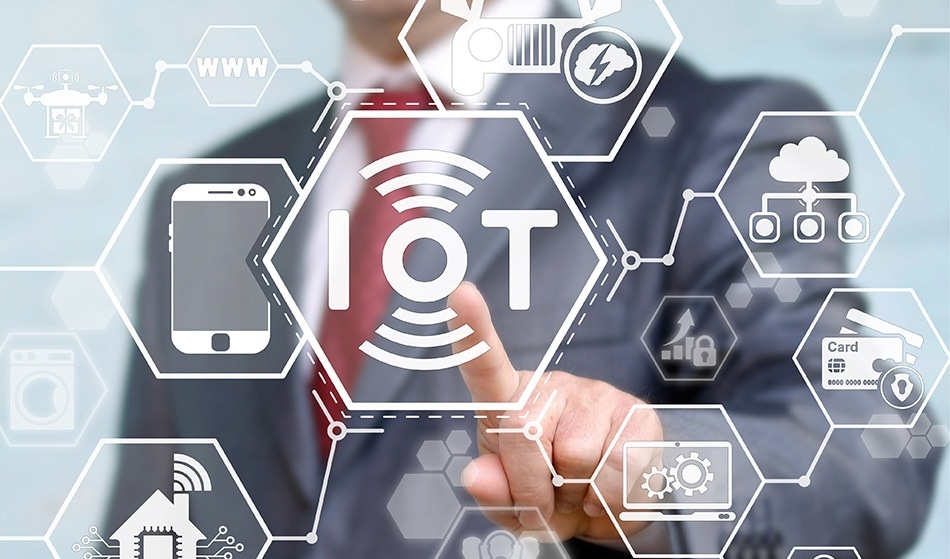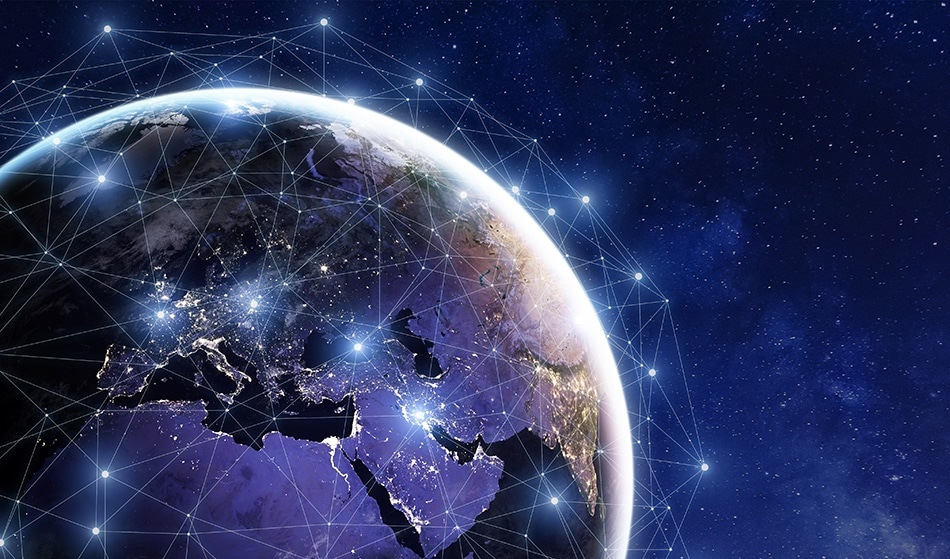The Internet of Things (IoT) refers to devices equipped with sensors, hardware, and software that connect to and share data with other devices and systems through the Internet or other communication networks. Almost anything can be made part of the IoT, and the connected devices can talk to each other. For instance, an ordinary alarm clock performs one function: to sound an alarm at a preset time, but an IoT clock could wake someone up, start the coffee maker, and instruct the cell phone to book a cab.

Panchenko Vladimir/Shutterstock
Currently, there are over 18 billion IoT devices worldwide, with the global IoT network rapidly expanding.1 IoT technology has the potential to power "smart cities," where transportation systems are synchronized with real-time traffic conditions, and vehicles autonomously choose the most efficient routes to reduce congestion and extend road life.
In a similar way, IoT systems optimize utilities such as water and electricity production, automatically adjusting supply for maximum efficiency. Depleted resources are reordered online, and smart waste management systems track waste levels in containers to calculate optimal collection routes. In healthcare, wearable devices equipped with IoT sensors can detect early warning signs of illnesses, enabling real-time diagnostics and preventive care.
The interconnected nature of IoT devices allows for comprehensive monitoring of both public behavior and environmental conditions. Governments and administrators can use the data collected to model scenarios and make informed decisions, driving efficiency and responsiveness. As the second digital revolution, IoT is poised to transform how industries, governments, and societies operate.2
Fundamental Elements of IoT
IoT is made up of several key components that work together to create a seamless and secure system capable of delivering real-time insights and automation.
- Devices and Sensors: These are physical objects equipped with sensors that collect data from their surroundings, such as temperature, motion, or light levels.
- Connectivity: Communication protocols like Wi-Fi, Bluetooth, and cellular networks allow devices to connect and transfer data to other systems or platforms.
- Data Processing: Collected data is analyzed either locally on the device (edge computing) or in the cloud, enabling the generation of insights or the triggering of specific actions.
- User Interfaces: Mobile apps or web dashboards provide users with tools to monitor, manage, and customize device settings based on their preferences.
- Security Measures: To safeguard the IoT ecosystem, security protocols and practices are essential to protect data, ensure device authentication, and prevent unauthorized access and cyber threats.3
The Role of Sensor Fusion in the Internet of Things
How Does IoT Work?
IoT operates by linking devices, sensors, machines, or appliances to the internet, enabling them to gather, transmit, and receive data. The process involves several key steps:
-
Connecting Devices: IoT connects physical devices, sensors, and systems via the internet, allowing for seamless data collection, sharing, and analysis. This interconnectedness enables devices to communicate instantly and work together to enhance operational efficiency.
-
Data Collection: Sensors embedded in IoT devices capture specific environmental data such as temperature, motion, and light levels. This real-time data provides valuable insights and forms the foundation for analysis and decision-making processes within the IoT ecosystem.
-
Data Transmission: The collected data is then transmitted to a central hub or cloud service through reliable communication options like Wi-Fi, Bluetooth, or cellular networks. Secure and efficient data transfer ensures that the information is accessible for centralized processing and analysis.
-
Data Processing: Data can either be processed locally on the device (edge computing) or in the cloud. Local processing allows for rapid response, while cloud processing handles more complex datasets and in-depth analysis. This stage generates actionable insights or triggers automated responses.
-
User Interaction: Users can interact with IoT devices through user interfaces such as mobile apps or web dashboards. These platforms allow users to monitor real-time data, manage devices, and customize settings based on their preferences. Intuitive user interfaces are crucial for effective system management.
-
Security Measures: Strong security protocols are essential for protecting data and authenticating devices. These measures prevent unauthorized access and safeguard the system from cyber threats, ensuring data privacy and maintaining user trust.
-
Autonomous Communication: IoT enables autonomous communication between devices, allowing for real-time insights and automation without constant human intervention. This leads to faster decision-making and greater operational efficiency in applications such as smart cities, healthcare, and industrial automation.
-
Integration of Machine Learning (ML): Many IoT systems incorporate machine learning algorithms to analyze past data, identify trends, and make predictive decisions. ML enhances the efficiency and adaptability of IoT systems, enabling smarter operations and more personalized user experiences.
-
Edge Computing Integration: By processing data closer to the source, edge computing reduces latency and enables real-time decision-making. This is particularly beneficial in applications like smart traffic systems, where immediate responses are necessary to optimize flow and reduce congestion.4

Image Credit: NicoElNino/Shutterstock.com
Diverse Applications of IoT
IoT applications extend across multiple sectors, driving efficiency, sustainability, and productivity:
-
Smart Homes: IoT devices such as thermostats, security cameras, and smart appliances enhance convenience, energy management, and safety for homeowners.
-
Healthcare: IoT enables remote patient monitoring and real-time data collection, improving patient care by allowing healthcare providers to track vital signs and detect issues early.
-
Industrial IoT (IIoT): In manufacturing, IoT optimizes processes through predictive maintenance, minimizing downtime, and improving asset tracking to enhance operational efficiency.
-
Smart Cities: IoT systems improve urban infrastructure by managing traffic, reducing waste, and increasing energy efficiency. This contributes to sustainable urban development, reducing congestion and environmental impact.
-
Agriculture: IoT enhances precision farming by using sensors to monitor soil conditions, weather, and crop health. This data-driven approach helps farmers make informed decisions on irrigation, fertilization, and livestock management, reducing water usage, increasing crop yields, and promoting sustainability in agriculture.5
Future Trends and Challenges
While IoT continues to expand, several challenges persist, including data security, privacy concerns, and interoperability between diverse devices and platforms. Managing the scalability of networks and handling large volumes of data are also significant hurdles. Future IoT applications are expected to grow in areas like smart cities, autonomous vehicles, and healthcare innovations, improving quality of life and operational efficiency. As technology advances, solutions that address these challenges will drive broader adoption and seamless integration across sectors.
Additionally, the rapid proliferation of IoT devices raises concerns about their environmental impact, particularly in terms of energy consumption and electronic waste. As more devices connect to the network, the need for energy-efficient solutions becomes increasingly important to minimize environmental harm. The lifecycle management of IoT devices, including responsible disposal and recycling practices, will be crucial in mitigating the growing problem of e-waste, ensuring that IoT's benefits do not come at the cost of environmental sustainability.5
For more on the applications of IoT, check out this article: Sensors and Internet of Things (IoT) in Logistics
Major Players in the IoT Market
Key market players like Cisco Systems, Siemens AG, and Google are at the forefront of developing innovative IoT solutions that enhance connectivity and data analytics. Their technologies drive advancements across multiple sectors, including smart cities, healthcare, industrial automation, and manufacturing.6
Cisco Systems focuses on robust network infrastructure, offering scalable IoT platforms that enable seamless connectivity across large and complex environments. Their solutions are particularly influential in smart city initiatives, where efficient data transfer and real-time analytics are essential for traffic management, energy efficiency, and public safety systems.
Siemens AG plays a pivotal role in industrial automation through its IoT-based solutions, such as the MindSphere platform. By integrating advanced sensors and AI-powered analytics, Siemens enables predictive maintenance, optimizing manufacturing processes, reducing downtime, and improving asset performance, all of which is essential for smart factories and Industry 4.0.
Google excels in data analytics and cloud computing, providing powerful tools for processing massive amounts of IoT data. Through platforms like Google Cloud IoT Core, Google empowers businesses to analyze real-time data streams, supporting applications in healthcare, where IoT-enabled wearables monitor patient health, and in autonomous vehicles, where real-time data processing is critical for navigation and safety.
Conclusion
The IoT revolutionizes how devices interact and communicate, enhancing efficiency across various sectors. It empowers smart homes, healthcare, manufacturing, and urban management, improving overall quality of life. Despite security, privacy, and scalability challenges, ongoing advancements drive its adoption. Key market players remain at the forefront, developing innovative solutions that shape the future of connected technology.
With the rising demand for IoT solutions, companies are putting more resources into developing strong cybersecurity protocols to safeguard sensitive information and maintain user confidence. The future of IoT is set for greater integration with cutting-edge technologies such as AI and ML, resulting in smarter and more flexible systems capable of adapting to changing needs and environments.
Sensor Technology: From Basics to Breakthroughs
Reference and Further Reading
- Internet of Things (IoT) connections worldwide. June 2024. https://www.statista.com/statistics/1183457/iot-connected-devices-worldwide/. Accessed on 1 Oct 2024
- Miller, B. (2016). What is the Internet of Things? GovTech. https://www.govtech.com/fs/what-is-the-internet-of-things.html
- Burhan, M., et al. (2018). IoT Elements, Layered Architectures and Security Issues: A Comprehensive Survey. Sensors, 18:9, 2796. DOI: 10.3390/s18092796, https://www.mdpi.com/1424-8220/18/9/2796
- Kaja Fjørtoft Ystgaard, et al. (2023). Review of the theory, principles, and design requirements of human-centric Internet of Things (IoT). Journal of Ambient Intelligence and Humanized Computing, 14:3, 2827–2859. DOI: 10.1007/s12652-023-04539-3, https://link.springer.com/article/10.1007/s12652-023-04539-3
- Morchid, A. (2023). Applications of internet of things (IoT) and sensors technology to increase food security and agricultural Sustainability: Benefits and challenges. Ain Shams Engineering Journal, 15:3, 102509. DOI: 10.1016/j.asej.2023.102509, https://www.sciencedirect.com/science/article/pii/S2090447923003982
- Andrei-Robert CAZACU. (2024). A Survey of IoT Frameworks for Low-Powered Devices. Information Economica, 28:2, 35-44. https://ideas.repec.org/a/aes/infoec/v28y2024i2p35-44.html
Disclaimer: The views expressed here are those of the author expressed in their private capacity and do not necessarily represent the views of AZoM.com Limited T/A AZoNetwork the owner and operator of this website. This disclaimer forms part of the Terms and conditions of use of this website.